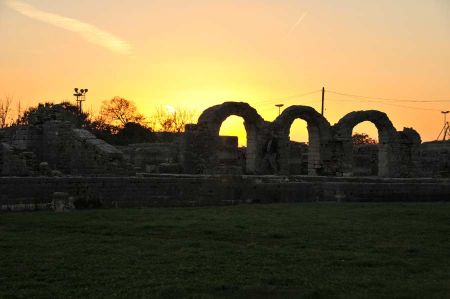The Amphitheatre of Salona next to Split
- Written by Portal Editor
As is unfortunately the case too often, this time our time window was too narrow, so we were only able to take a short tour of the amphitheatre in Salona. Nevertheless, we were deeply impressed by what we were to see in the immediate vicinity of Split: the remains of the monumental amphitheatre building from Roman times.
Today you can only see large parts of the substructure of this monumental amphitheatre, as well as individual pieces of decoration scattered around.
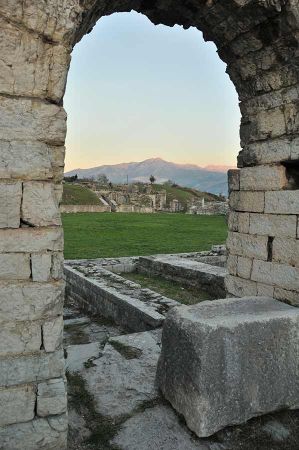 During the heyday of the ancient Roman city of Salona, construction of the amphitheatre began in the northwest corner of this metropolis and only after the complex city walls were built.
During the heyday of the ancient Roman city of Salona, construction of the amphitheatre began in the northwest corner of this metropolis and only after the complex city walls were built.
This is rather unusual for Roman city planning, as it is quite difficult to accommodate such a monumental building of at least 125 x 120 meters in a city.
No wonder, then, that the theatre and parts of the surrounding walls to the northwest were integrated into Salona's defence system.
And it was our expert Robin to explain lot of details, not just about the Amphitheatre but about the struggle to keep this monument as a cultural heritage.
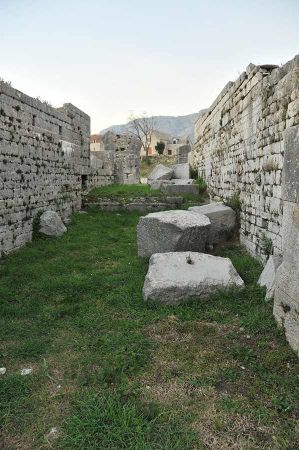 In contrast to the theatre buildings, the amphitheatres were planned and implemented from the outset for gladiator fights, but scientists still argue today whether the amphitheatres were created from the joining of two theatre buildings or whether there were fundamentally two completely different developments that only took place were developed by the Romans in the form of the amphitheatre.
In contrast to the theatre buildings, the amphitheatres were planned and implemented from the outset for gladiator fights, but scientists still argue today whether the amphitheatres were created from the joining of two theatre buildings or whether there were fundamentally two completely different developments that only took place were developed by the Romans in the form of the amphitheatre.
Here in Salona, there was once room for around 17,000 spectators to watch the gladiator competitions live. The arena alone was 65 x 40 meters in size and was almost completely surrounded by a covered corridor paved with natural stone.
Approximately in the middle of the arena there was access to an underground passage through which injured or dead gladiators could be transported away.
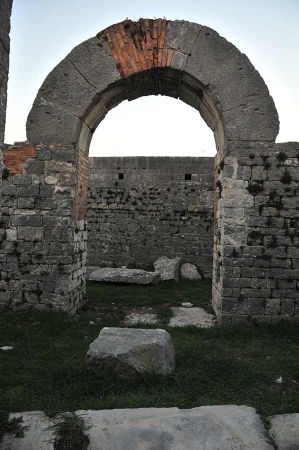 Even back then, comfort for visitors was a top priority, so there was a division of the spectator area into three tiers: the city's wealthy citizens and notables sat in the first tier, the normal middle class sat in the middle tier and there was standing room for the rest of the public in the third tier.
Even back then, comfort for visitors was a top priority, so there was a division of the spectator area into three tiers: the city's wealthy citizens and notables sat in the first tier, the normal middle class sat in the middle tier and there was standing room for the rest of the public in the third tier.
On the south side within the spectator area was the particularly splendidly designed honorary box of the praetor of the province of Salona, while the city magistrates had to sit on the tribune opposite.
As in other amphitheatres, wooden structures were attached to the upper external facade of the theatre to which canvas awnings could be attached to protect the audience.
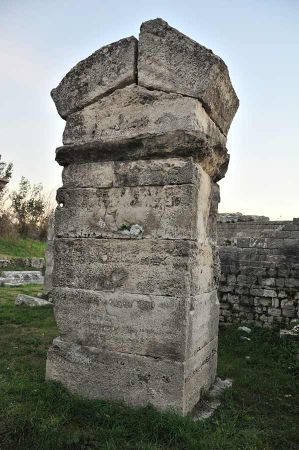 The main entrances were located in the east and west of the amphitheatre, and there were cages for the predators on both sides, so that spectators could also pass through the animals in the cages as an "animal show".
The main entrances were located in the east and west of the amphitheatre, and there were cages for the predators on both sides, so that spectators could also pass through the animals in the cages as an "animal show".
During the excavation work, the gladiator cemetery was also found on the north side outside the theatre; inside there were two vaulted rooms that were set up to pay homage to the goddess Nemesis (goddess of revenge). The Goddess Nemesis was a patron saint of gladiators.
With the spread of Christianity, as is well known, Christians were initially persecuted by the Romans and the first Christian martyrs of Salona even lost their lives in the theatre, so it is no wonder that the Nemesis memorial rooms were later converted into memorial chapels.
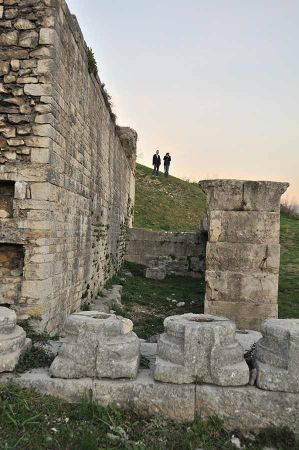 After Christian thought was transformed into a state philosophy, walls and ceilings were decorated with fresco paintings about the lives of Christians, which were rediscovered during excavations.
After Christian thought was transformed into a state philosophy, walls and ceilings were decorated with fresco paintings about the lives of Christians, which were rediscovered during excavations.
When the Turks advanced further and further into Split, which was under Venetian rule, in the 17th century, a large part of the amphitheatre was demolished for strategic defensive purposes on the orders of the Venetian governor.
Please read as well:
The Diocletian's Aqueduct in Split
Salona - capital of the Roman province of Dalmatia
Diocletian's Palace in Asphalatos, then Spalato and today Split
-
 Salona - Roman Amphitheatre Split
Salona - Roman Amphitheatre Split
Salona - Roman Amphitheatre Split
Salona - Roman Amphitheatre Split
-
 Salona - Roman Amphitheatre Split
Salona - Roman Amphitheatre Split
Salona - Roman Amphitheatre Split
Salona - Roman Amphitheatre Split
-
 Salona - Roman Amphitheatre Split
Salona - Roman Amphitheatre Split
Salona - Roman Amphitheatre Split
Salona - Roman Amphitheatre Split
-
 Salona - Roman Amphitheatre Split
Salona - Roman Amphitheatre Split
Salona - Roman Amphitheatre Split
Salona - Roman Amphitheatre Split
-
 Salona - Roman Amphitheatre Split
Salona - Roman Amphitheatre Split
Salona - Roman Amphitheatre Split
Salona - Roman Amphitheatre Split
-
 Salona - Roman Amphitheatre Split
Salona - Roman Amphitheatre Split
Salona - Roman Amphitheatre Split
Salona - Roman Amphitheatre Split
-
 Salona - Roman Amphitheatre Split
Salona - Roman Amphitheatre Split
Salona - Roman Amphitheatre Split
Salona - Roman Amphitheatre Split
-
 Salona - Roman Amphitheatre Split
Salona - Roman Amphitheatre Split
Salona - Roman Amphitheatre Split
Salona - Roman Amphitheatre Split
-
 Salona - Roman Amphitheatre Split
Salona - Roman Amphitheatre Split
Salona - Roman Amphitheatre Split
Salona - Roman Amphitheatre Split
-
 Salona - Roman Amphitheatre Split
Salona - Roman Amphitheatre Split
Salona - Roman Amphitheatre Split
Salona - Roman Amphitheatre Split
-
 Salona - Roman Amphitheatre Split
Salona - Roman Amphitheatre Split
Salona - Roman Amphitheatre Split
Salona - Roman Amphitheatre Split
-
 Salona - Roman Amphitheatre Split
Salona - Roman Amphitheatre Split
Salona - Roman Amphitheatre Split
Salona - Roman Amphitheatre Split
-
 Salona - Roman Amphitheatre Split
Salona - Roman Amphitheatre Split
Salona - Roman Amphitheatre Split
Salona - Roman Amphitheatre Split
-
 Salona - Roman Amphitheatre Split
Salona - Roman Amphitheatre Split
Salona - Roman Amphitheatre Split
Salona - Roman Amphitheatre Split
-
 Salona - Roman Amphitheatre Split
Salona - Roman Amphitheatre Split
Salona - Roman Amphitheatre Split
Salona - Roman Amphitheatre Split
https://www.alaturka.info/en/croatia/split/6337-the-amphitheatre-of-salona#sigProIdb3a3c27ab1
